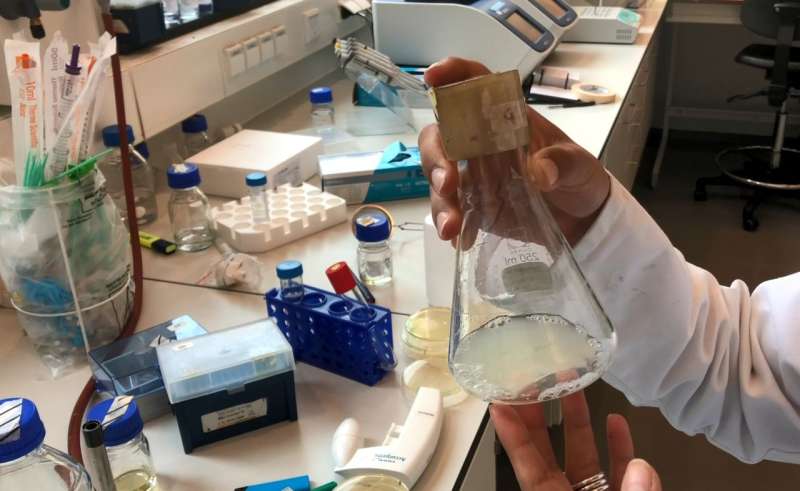Bacteria as living factories for the production of powerful antibiotics

By definition, antibiotics kill bacteria. Nevertheless, TU Delft researchers have succeeded in engineering bacteria to produce promising amounts of a simple carbapenem antibiotic. Carbapenem antibiotics are effective against many bacteria and are usually only used when other antibiotics fail. They are currently only produced synthetically – an expensive process that also leads to chemical waste. This research suggests that by using bacteria as "living factories," carbapenems might also be produced biologically.
Antibiotics are all around us. If you dig up a handful of soil from a random garden, it is likely to contain an antibiotic that is yet unknown. Microbes naturally produce small amounts of bacteria killing compounds in order to protect themselves against other microbes. Unfortunately, we are unable to produce many of the antibiotics that can be found in nature, for instance because the organisms that produce them will not grow in the lab or in a fermenter.
Growing resistance
Now, many of our current antibiotics are becoming less effective. Bacteria that are resistant to many families of antibiotics are rapidly spreading. One of the last-resort effective antibiotics are the so-called carbapenems. "These antibiotics disrupt the formation of the cell wall, ultimately causing the bacteria to explode," explains researcher Helena Shomar, who led the project.
However, carbapenems also have their disadvantages. For example, they cannot be produced through microbial fermentation, but only via synthetic chemistry. As a result, carbapenems are expensive, and the development of new variants is limited. "The synthetic production of carbapenems is also bad for the environment, as you are left with chemical waste at the end of the process," adds group leader Greg Bokinsky.
Microbial factories
The Delft researchers devised a counterintuitive solution for these issues. They engineered E. coli bacteria to produce Car, a relatively simple carbapenem antibiotic. "To do so, we borrowed the few genes that are known to be responsible for the production of Car from another bacterium called P. carotovorum," says Shomar. "We then introduced these genes into E. coli."
Introducing the Car genes into E. coli did result in the bacteria producing the antibiotic, but only in small amounts. Shomar: "To prove that this approach could eventually enable the mass production of carbapenems, we needed our E. coli to generate more."
Two additional steps were required to increase the production. The most significant bottleneck was an inefficient enzyme. The researchers introduced an additional gene into E. coli to produce a protein that helps this enzyme become more active.
Another limitation was the toxic effects of the antibiotic on the engineered E. coli bacteria. They produced so much Car that the population started dying very rapidly. To delay the microbes' death as much as possible, the researchers made them artificially persistent. "Persistent bacteria do not grow, which allows them to survive for longer in the presence of these antibiotics," explains Shomar. The technique kept the bacteria productive for slightly longer, allowing them to generate more Car.
The engineered E. coli are a proof of concept. "Even if the idea sounds counterintuitive, our research suggests that E. coli has the potential to produce carbapenems," says Shomar.
The amount of carbapenem made by the engineered E. coli – about 54 milligrams per litre – is indeed promising, but not enough for mass production. "However, with a handful of additional steps, we might be able to use this method to produce more complex carbapenems, in quantities compatible with mass production," says Bokinsky.
And how long will it be before these additional steps are taken? "About five to 10 years would be my optimistic estimate," says Bokinsky. "But for this to happen, a team of about 10 researchers working in parallel would have to work on it full-time."
More information: 'Metabolic engineering of a carbapenem antibiotic synthesis pathway in Escherichia coli', Helena Shomar, Sophie Gontier, Niels J. F. van den Broek, Héctor Tejeda Mora, Marek J. Noga, Peter-Leon Hagedoorn & Gregory Bokinsky, Nature Chemical Biology, DOI: 10.1038/s41589-018-0084-6
Journal information: Nature Chemical Biology
Provided by Delft University of Technology














.jpg)





